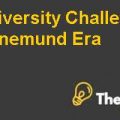Eskom Crisis Case Solution
Consequences:
Decisions made:
The decision of convincing the Legislature for the provision of bailout for SOE,represents the need to know what is expected from them in the next bailout. Based on this fact, Eskom was found to be based on policy or discretion.(Pauw, 2017)
Considering the signing of IPP’s contract, although it was admitted by the Eskom management that IPP project was the reason behind its financial crisis. Eskom had oversupply of electricity, which represented the pursuit of IPP as senseless for the state. Despite the consideration of financial crisis, the project was to cost more than a trillion to the taxpayers and was expected to result in increased cost of electricity for the consumers. In terms of building a new power station with debt, the contribution of shareholders was around 60 percent of the fund required to make such investment. But, the government raised all 100 percent in debt, which burdened the Eskom to find the potential resources in order to pay the interest at the time of building phase. (Gedye, 2018)
The decision to provide the loan to Tegeta was considered as an approach to repay for future coal deliveries. This decision was made by the board members of Eskom. Because around 7 percent of the Eskom’s coal was supplied by Tegeta which was huge. It was quite apparent that the some of the board members who approved the loan lacked knowledge about the true payment nature. But, the provision of loan was to reduce the conflict of interest because the probability of the conflict to become bigger is reduced there is friendly relation between the investor in coal mining and the biggest user of coal in the state. But, this approach was found to be inconsistent with PFMA. (Public Finance Management Act). (Styan J. B., 2016)
Decisions not made:
According to Eskom, the problem did not lie in the high cost of the labor or being overstaffed. It was primarily associated with the poor management choices because of which labor should not suffer.However, Eskom with 80 people was stronger that it is today. The utility was found to be focused on negotiating about the increase in wages of labor of either 7 percent or 7.5 percent which was surely not an effective approach to deal with the financial crisis. Although the recommendations provided by the union were said to result in retrenchments and increase the cost for consumers. (Gedye, 2018)
The retrofit of executing an emission reduction program was estimated to cost around R134 billion, but Eskom lacked enough cash. The reality of the environment targets and challenges of South Africa related to the mitigation of climate change was known to be the key reason why the government and Eskom were found to be so insistent on nuclear power.Similarly, the inability of the organization to invest in waste reduction and controlling the emission of greenhouse gases could turn out to be a source of cost saving and shift the financial instability to profitable state. But, the management did not take time to evaluate the resources and stated that they didn’t have money. (Styan J. B., 2016)
Questions in decision-making chain:
The possible questions that can be significantly outlined over the discussion of the strategic decisions made and not made by Eskom could be:
- Can reduction in the labor cost bring reduction in the operational cost of the utility?
- Is there a resource of operational conduct that can be minimized to make investments in sustainability rather declaring the fact that the utility had no money?
- Shouldn’t the receiving of SOE bailout pros and cons be evaluated before convincing the Legislature regarding the possibilities of tax rates and other related factors?
- Whether the signing of IPP contract was the priority than to invest in other areas where there was a requirement of reducing the emission of CO2 and other pollutants to bring significant reduction in waste?
Teachings about decision making:
The case of Eskom to convince the legislature for bailout represented the need to maintain the balance between policy and discretion. Because the existence of policy in the absence of discretion would result in failure. For Eskom, if the probability of failure was huge, it should have made smaller approach to improve the strategic economic significance.(Pauw, 2017) In order to make clear decisions, the clarity of the decision makers is of great importance,which requires the availability of critical information an lionization. (Styan J. B., 2016)
Thus, the approach of decision making must be based on the exploration of future scenarios which were not considered by the management of Eskom while making any decision. (Walters, 2020)Similarly, the consideration of butterfly effect of Lorenzo is important, because small and evaluated actions can have non-linear impact on the complex system. This would increase the complexity of the situation or the decision despite reducing it. (Making, 2019)
Additionally, the approach of decision-making, the nature of the complexity of the decision can be done by evaluating the history of the organization. Also, the approach of decision-making should be broadened with the traditional approach,depending on the type of issue and current dynamics of the industry. (Making, 2019) Because decision makers tend to be dependent on the models of data-based decisions and statistical findings to tackle the problem and form strategic approach. (Soyer, 2015)
Teachings about critical thinking:
The approach of critical thinking was not observed in the decision making approach at Eskom. In order to develop a better understanding regarding a social concern, such as: the provision of electricity in case of Eskom, effective communication with the executives in the industry and the government assist in the application of complex thinking. (Stanbridge, 2004)Critical thinking is not only based on the clarity of language but also relates to the maximum clarity of thoughts. Critical thinking requires the thinkers to focus on timely and accurate information.
Critical thinking assists to be aware of the unconscious inconsistencies of the practices followed,which would allow the decision makers to efficiently deal with the rational and conscious bias. For instance, the case of over-staffing at the Eskom which required decision makers to think critically and make a logical and unbiased decision. Thus, the decision about the labors shouldn’t have been based on the fairness of terminating employees but should rather on continuing with the employees with good communication and thinking skills.(Gregory Bassham, 2011)
Conclusion:
Based on the issues faced by Eskom regarding the generation of electricity, Eskom had been borrowing money to repay its debt. The financial meltdown and electricity outrage led to increased accusations and speculations associated with Eskom affairs and its utilization of public funds.The. management of Eskom lacked an effective approach of decision-making,which led to a significant increase in the financial crisis. Similarly, the decisions were not analyzed because execution caused change in the environmental and political concern,badly influencing the positioning of Eskom in the country....................
This is just a sample partial case solution. Please place the order on the website to order your own originally done case solution.













